Modern bikes are either fitted with clipless pedals or flat pedals (not counting the odd fixie with toe clip pedals), or a combination of clipless and flat known as hybrid pedals.
Which type of pedal—clipless or flat—is appropriate for each cyclist depends on several interacting factors :
- the broad category of cycling: road, mtb, commuting, cyclocross, trekking
- mode of cycling: functional, fashionable, recreational
- personal preferences
- functional requirements
CONTENTS
Road Bikes
Flat pedals > Toe clips > Clipless
How are Clipless Pedals Better?
Clipless Commuting
Pop up Clipless/Flat Pedals
Mountain Bikes
Clipless vs Flat Pedals in General
Lifting & Jumping Skills
Dropping Skills
Racing/Endurance
Other
Hybrid: Clipless & Flat in One
FAQ
Clipless HORROR Story
The Last Word: Clipless/Fat is not either/or
CLIPLESS and FLAT PEDALS – ROAD & MTB
The journey from flat pedals to clipless pedals has progressed through three phas- es—flat, to toe clip, to clipless.
Although the broad design possibilities—even pedal ‘evolution’ if you like—are seemingly exhausted having arrived at clipless, we have seen an increase in variety within this category.
And we have now arrived at the point where clipless and flat pedals are, more often than not, placed in opposition to each other, which is unfortunate since they are not necessarily in opposition at all.
It comes down to the practical issue of what pedal works in for specific riding purposes at a particular time.
Having said this, the best use scenarios do tend to fall into the road bike or mountain bike camp, even though pedals designed ideally for one discipline can be used on the other.
Convention may frown on such boundary blurring. But if it works for you, why the hell not?
Road Bikes
The first Bike was a road bike.
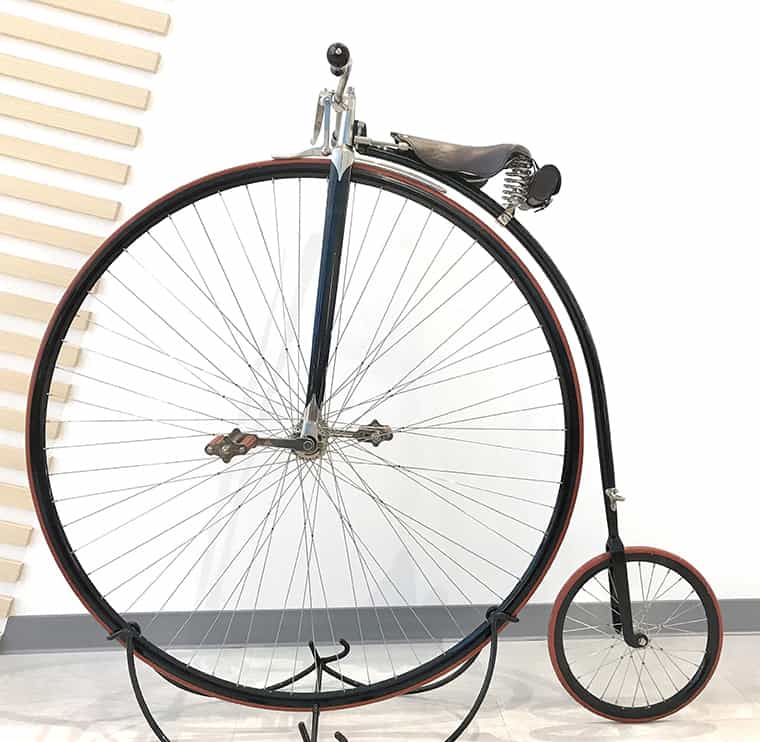
Original pedal design, thus, all began on (often pretty lousy) roads and was aimed at enabling a rider to mount and maintain momentum on what were fairly dicey machines, you have to admit.
From flat pedals to toe clip to clipless
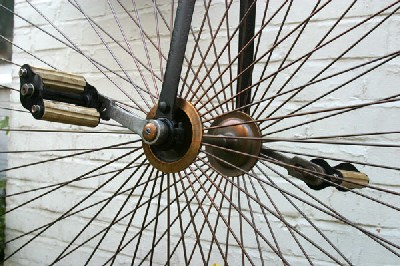
Pedal design started with a direct drive crank fixed to the wheel hub at one end and fitted with a simple flat pedal at the other.
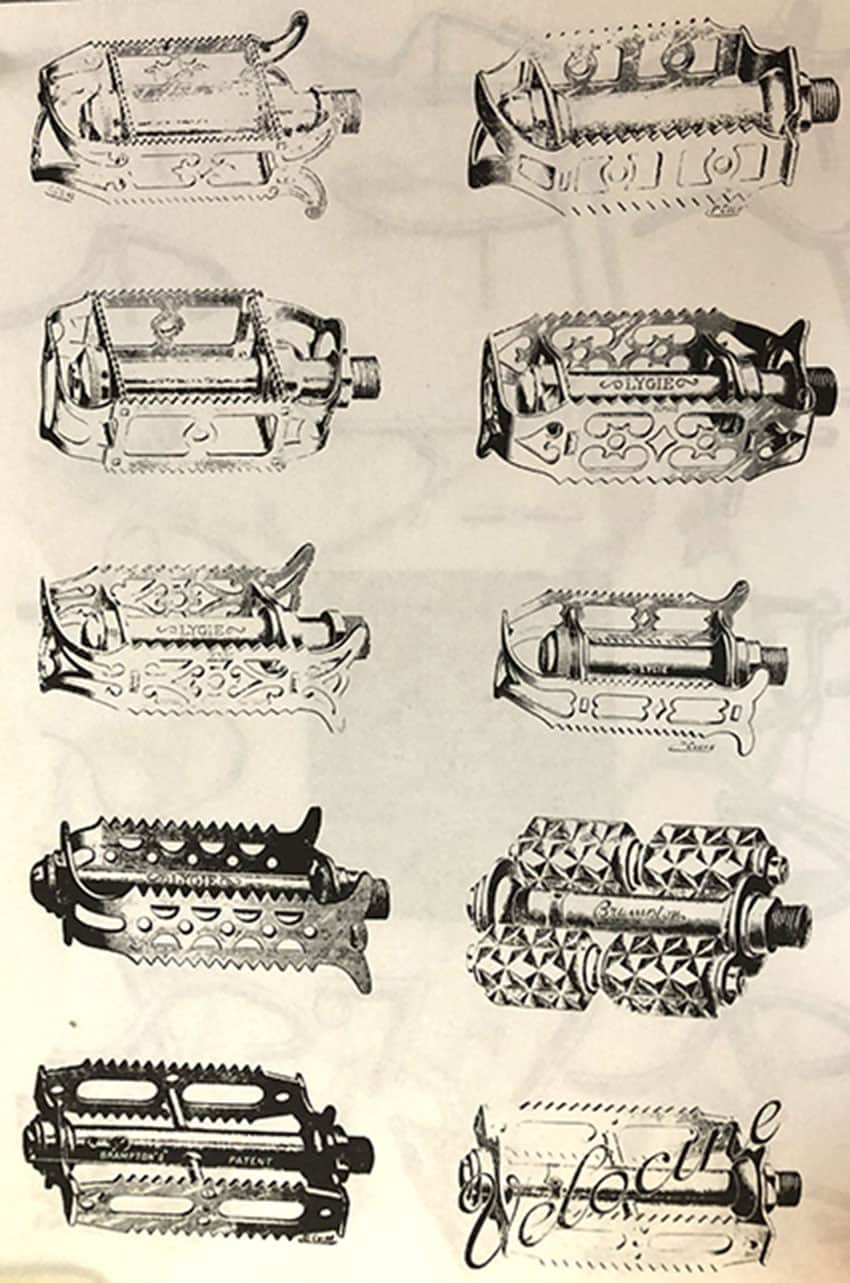
After a few decades, although the variety had increased, flat pedals were the norm without any significant innovation.

Push on the pedals, and the bike goes forward. What more would you want (apart from not coming a cropper)?
Well, how about gaining more push without extra exertion?
The modern world is built on efficiency, so ‘rationalizing’ the process of pedal- ing a bike was only a matter of time.
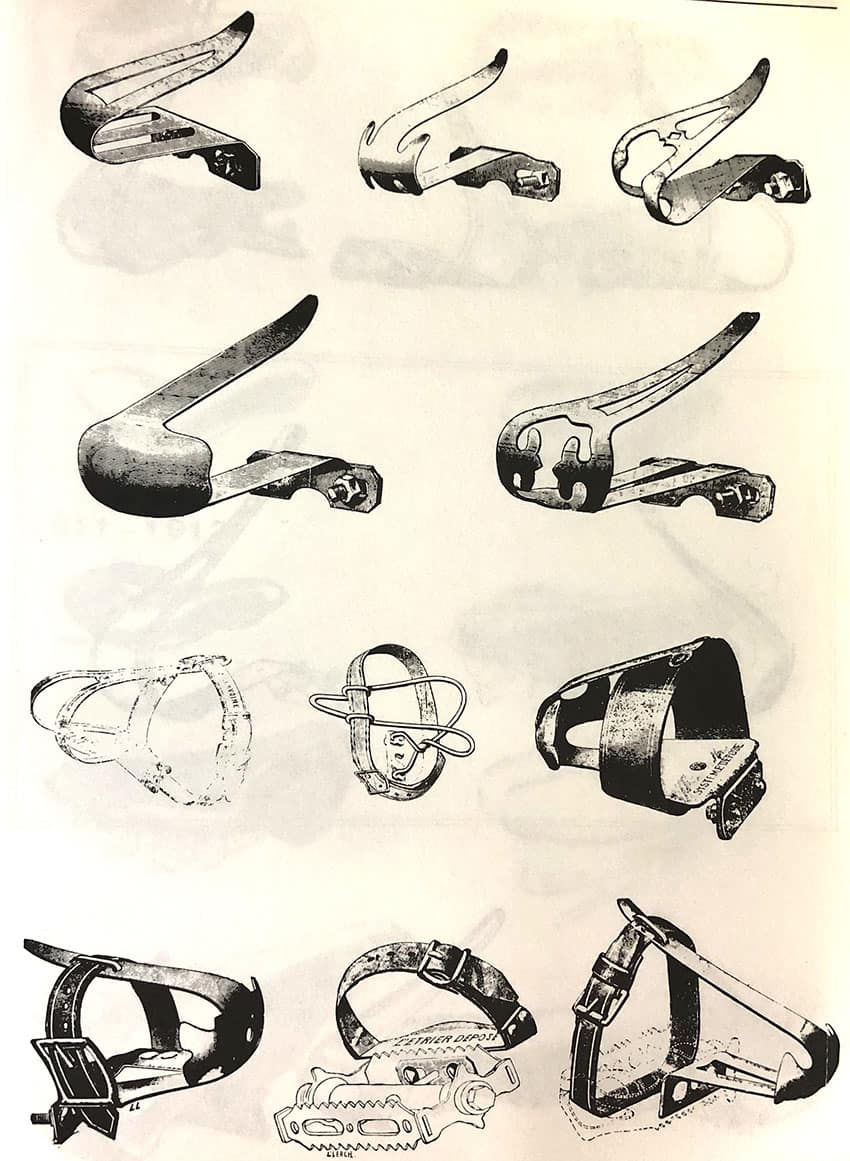
After a few decades of using flat pedals, the simple innovation of clipping a cage to the front of a flat pedal in conjunction with a strap was a major leap—the inven- tion of the toe clip pedal delivered an energy boost without a rider necessarily putting in extra effort.
The goal of the design is to achieve greater efficiency by gaining greater leverage: the cyclist’s foot, in its capacity as a lever, gets that leverage by bracing against the cage.
This action converts energy that would have been focused as downward pres- sure on the pedal’s platform in order to keep the foot firmly in contact with the plat- form, into forward motion.
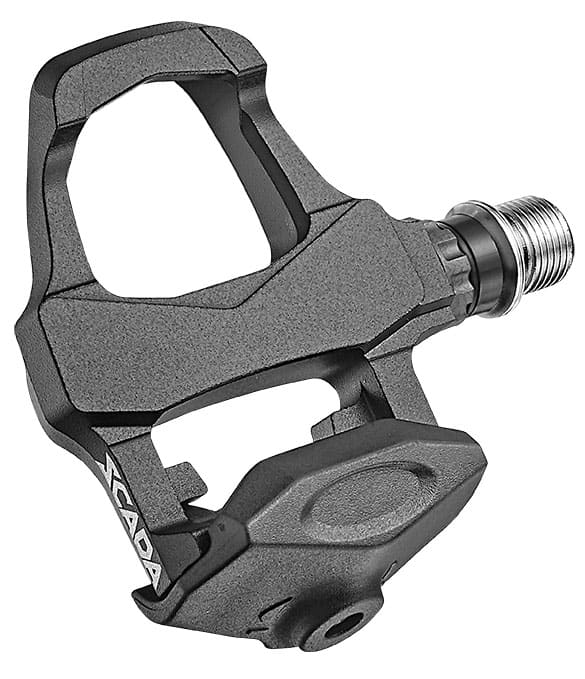
In the early 1980s taking snow ski bindings as inspiration (a design innovation just waiting to happen) Look disposed of the cage, replacing it with a bracket and cleat. And although the pedal lost the clip—thus becoming clipless—the goal re-
mained unchanged and even enhanced, since clipless pedals allow the cyclist to extract energy from the otherwise dead part of the pedal cycle stroke.
With a clipless pedal you can both push and pull, thus directing potential ener- gy into the kinetic energy of forward movement.
How are clipless pedals better than flat pedals?
You’ll be quick to point out this as a silly question after the reasons spelled out in the preceding section.
But, wait up. Sure, uber-efficiency is mandatory for pro cyclists; and many ama- teurs also insist on getting the most out of every calorie.
Nevertheless, the majority of road cyclists engage in the sport in pursuit of life- style goals, and for them clipless can be viewed as working against that objective, in a way.
If exercise and weight loss is your deal, the more energy expended the better.
A lack of efficiency means a slightly higher heart rate and more calories con- sumed.
You won’t go as far, as fast—and that does not matter. Nor will you notice it.
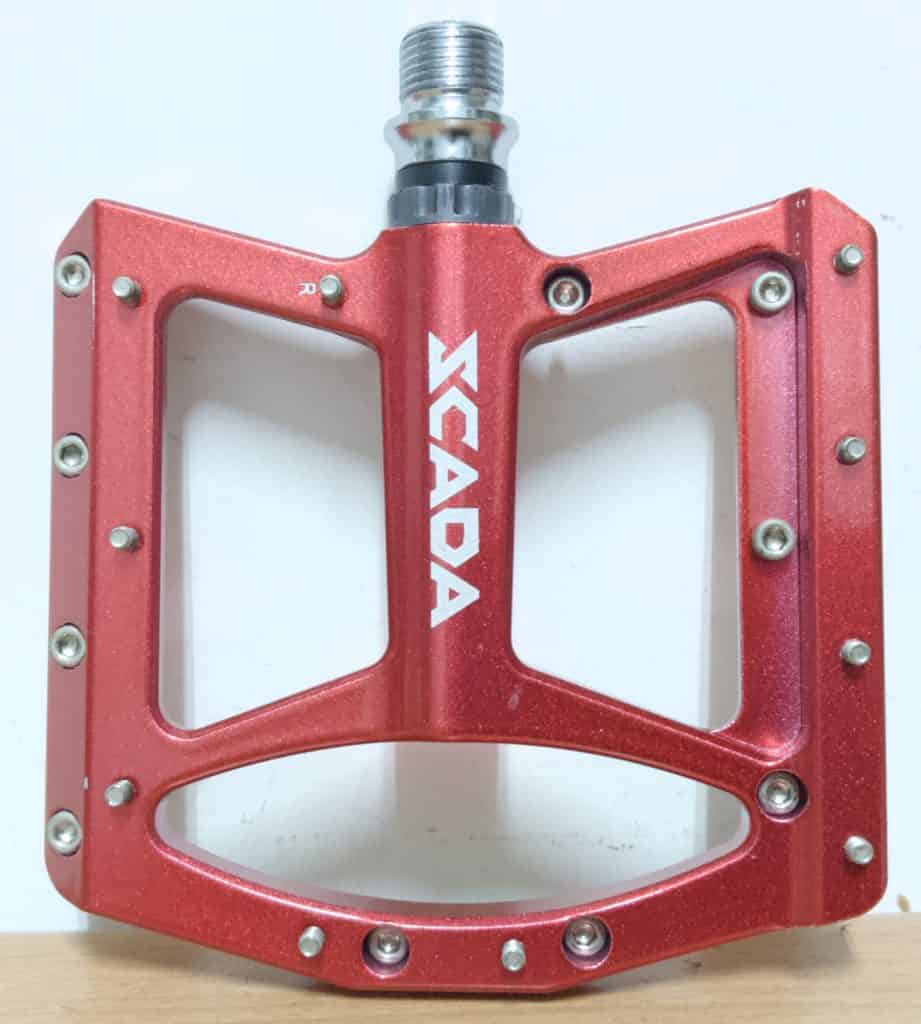
Grippy flat pedals trump clipless in this regard: you get a broad, stable surface that your shoe will stick to like glue if you opt for pins.
Probably a lot of cyclists opt for clipless rather than flat pedals since that’s the norm for the people they ride with.
In that case, it’s clipless all the way.
The ebike revolution seems set to balance the scales in that regard since elec- trification makes efficiency a non-issue.
A mid-drive or hub motor promises to be a great equalizer since all inefficien- cies—weight, strength, fitness, age, training—are cancelled out.
Howevera major downside to going clipless compared to staying with flat are the consequences of not clipping out when you need to. (I cover this in the ‘Clip- less Horror Story’ below).
Even though problems are rare, clipping-in is always risky.
Clipless commuting
There’s probably even less rationale for installing clipless rather than flat pedals on a commuter or city bike…or even a trekking bike for that matter.
There are those who commute on high-performance road bikes (and mountain bikes) where clipless arguably gets you there in less of a sweat as you would prob- ably prefer before a day’s work.
Otherwise a leisurely cruise to a destination is achieved perfectly with a pair of flat pedals, or their close cousin, city bike pedals.
And true leisure means frequent stops since there’s no point-A to-point-B ur- gency.
If you’re stopping and walking around then clipless is out and flat is in (remem- bering that walking on cleats is lethal on smooth surfaces, let alone smooth and wet surfaces).
Pop up double sided clipless flat pedal
Although this pedal design has been around for a long time, it is a niche product favored by a small number of cyclists, surprising as it combines the best of both world’s (even more than hybrid which I touch on below).
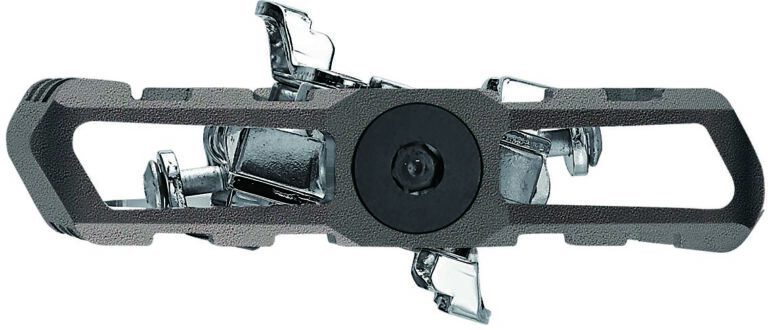
This pedal is easily used simply as a flat pedal with any type of shoe. A sports shoe would be best, but not necessary; any flat sole shoe does the job.
The clip-in mechanism on most of these models rotates 12 degrees; this model rotates a maximum of 15 degrees.
Hybrid pedals which are clipless on one side, flat on the other, and require a cyclist to divert concentration from cycling to flipping the pedal to the flat or brack- eted side.
Pop ups don’t demand this level of rider input. Once you get the clipping in procedure dialed, it becomes automatic.
As a commuting pedal, this particular clipless flat pedal model is both an ele- gant and practical solution.
Mountain Biking
The debate over whether clipless or flat pedals is better for mountain biking continues.
The consensus of opinion amongst performance-oriented mountain bikers— most of whom use both depending on their riding goals at the time—is that clipless pedals hold back the development of high level skills.
Moving back to flat from clipless is not a simple matter though: a rider brought up on clipless has to overcome the years of clipless muscle memory built into their quads and calves which requires dedicated (de)conditioning to overcome.
It’s worth it as reprogramming legs honed with flat pedal-enhanced skills deliv- ers a clipless-level performance without the clips/cleats.
The argument is that skills learned on flat pedals will result in better skills when using clipless.
Clipless vs Flat Pedals in General
Riding rough terrain, executing controlled slides of the back wheel, and lifting the rear wheel is easier with clipless pedals.
With flat pedals you can avoid the build-up of mud on the brackets. Generous spacing between a pedal’s crossmembers prevents excessive gunk build-up on the pedals.
Pedal and shoe also deliver a lower center-of-mass/gravity since they are thin- ner (and often lighter) compared to clipless.
A marginal effect for most riders, although millimeters make a big difference for the pros.
Lifting & Jumping
An experienced rider is half way through his customary early morning 30 km circuit through the hills along narrow roads in the foothills of Taiwan’s alpine region, near Taichung.
At the top of a climb he picks up speed on the flat, probably too much since he rounds a corner to find a small tree lying across the road where a farmer is clearing land that slopes up from the road.
No way to stop.
So he lifts the front wheel over the log then, since he is clipped-in, he also lifts the back wheel over the log as the front touches down—a classic bunny hop.
The hop is easy to learn and arguably an essential technique for every cyclist to master in order to avoid obstacles that suddenly appear on the road leaving no choice but to jump them.
The problem is, the argument goes, clipless pedals make you lazy due to the attachment; if you’re on flat pedals, you have to learn to put your whole body into the maneuver, starting with using the broad surface of a flat pedal for leverage.
The serious mountain biker will appreciate their greatly enhanced jumping skills when opting for flat over clipless, even if only for training purposes.
Few experienced mountain bikers will tell you their technique has not signifi- cantly benefited from training on flat pedals and, in some cases, using them much more than clipless.
Dropping—tricky unclipped
If you are used to being clipped in, then executing a drop on the trail using flat pedals will be awkward, even dangerous, as shoe and pedal can quickly and easily part company.
Rather than simply allowing the bike to drop away, the rider must actively ‘ride’ it down. Angling heels down makes it easier to maintain shoe/pedal connection.
Racing/Endurance
The physiology of flat pedals is all about the push.
And when a rider tires, the tendency is to double down on the pedals, push harder, grind a way through to the end.
The universal advantage of clipless is the smooth injection of energy into the drive train on the upstroke of the pedal cycle.
All things being equal, a cyclist with clipless
So, fine. Maybe on competition day you’ll go clipless. Other times you’ll use flats.
HYBRID BRIDGES THE CLIPLESS / FLAT PEDAL DIVIDE (to a degree)
Hybrid pedals provide the way out of an either/or argument.
A cyclist can have their cake and eat it too in a pedal that is clipless on one side and flat on the other.
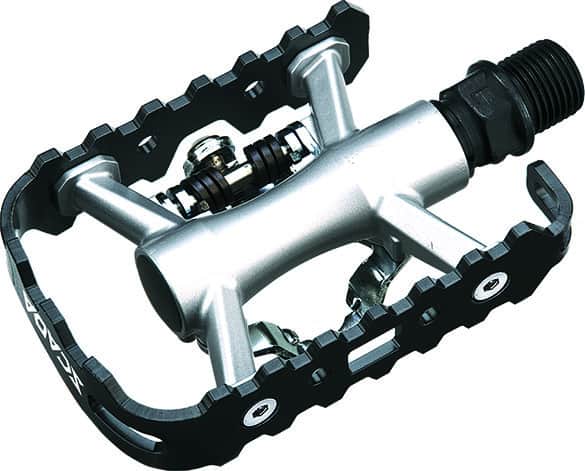
Most cyclists will recognize this basic pedal as similar to the one they had on their bike as a kid. Well, apart from the clip-in bracket on the reverse side.
The flat side offers a serrated cage providing good grip in non-demanding riding circumstances.
Flip it over to clip in.
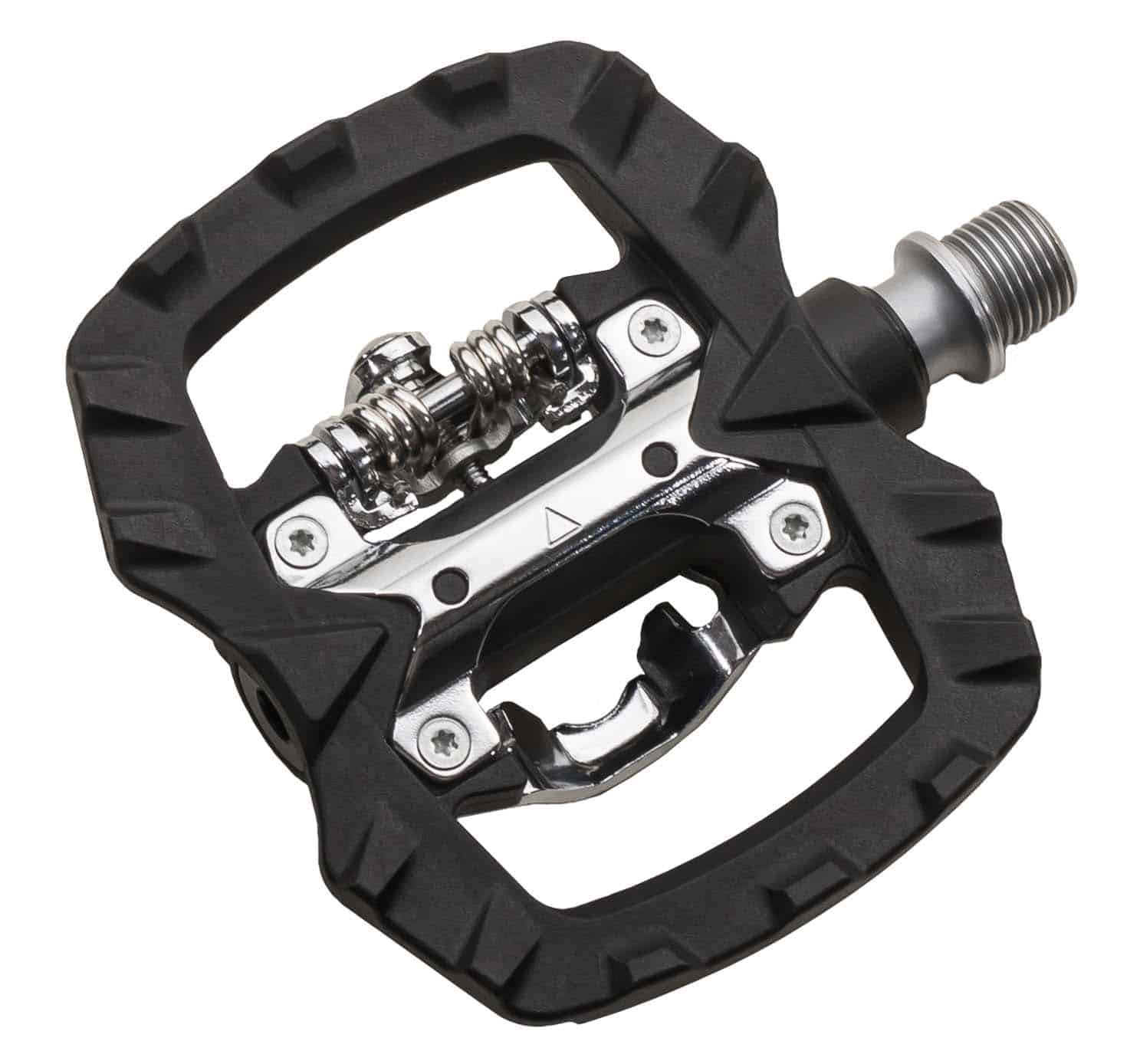
Most cyclists would probably prefer to start with a degree of elegance, as with this model.
The bosses on the platform may not provide the grip you’d get from pins. How- ever a shoe sole with decent tread will find good purchase right around the plat- form.
The best grip on a flat pedal platform is provided by pins.
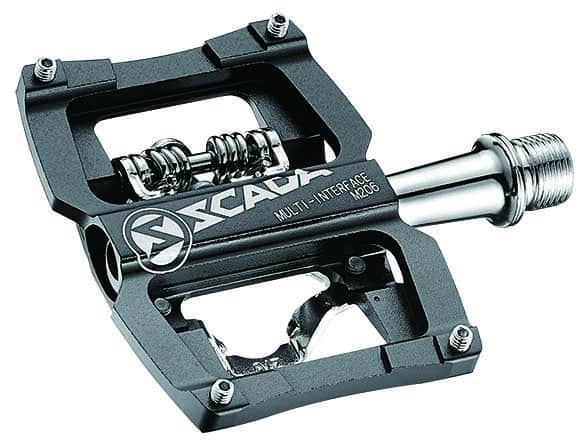
A basic threaded pin, one on each corner provides good grip.
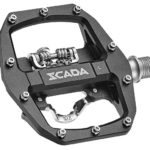
10 pins are better, of course.
FAQ
Can You Wear Clipless Shoes on Flat Pedals?
Perhaps the question is better phrased as should you wear you wear them on flat pedals?
The answer, though, depends on whether you are on a road bike or mountain bike.
Road bikes – clipless to flat
You most definitely should not wear clipless shoes on flat pedals—not with the cleats on at any rate, and probably not with them removed either.
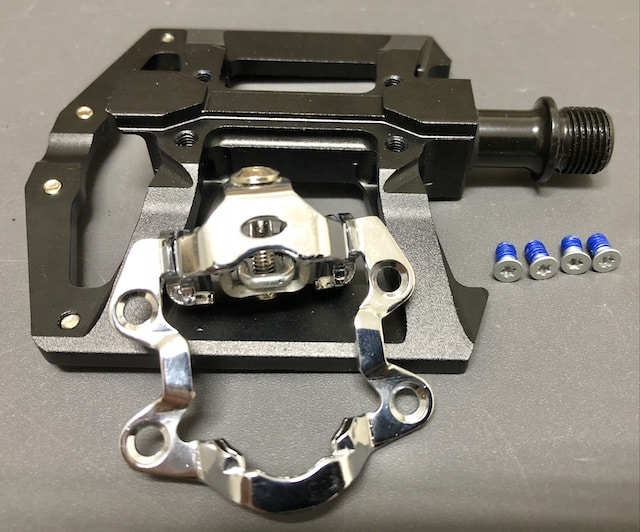
Removing the cleats is easy. Just undo the bolts.
The problem is the shape of the shoe sole which is designed for stiffness and
incorporates curvature to fit the foot arch—the higher quality shoes anyway—and to accommodate the cleat.
Hard, slick soles will not grip very well at all on broad platforms and, especially, pins.
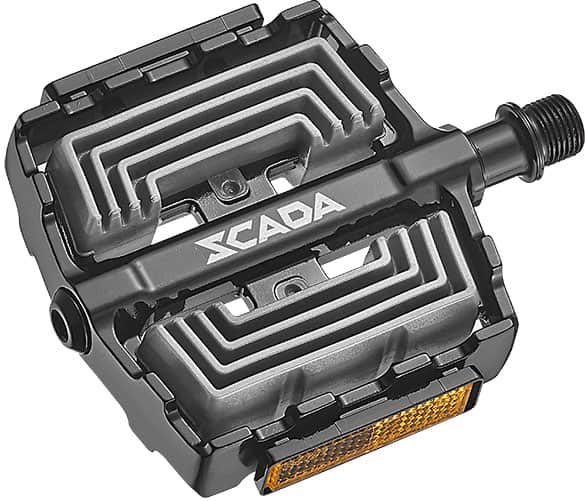
A flat pedal such as this one inlaid with kraton synthetic rubber, however, can com- fortably accept smooth and, let’s say, ‘non-standard’ soles.
You could use your clipless shoes minus the cleats without slipping (much), but the more sensible option is to go for a mountain bike setup.
Mountain bikes – clipless … and flat
An mtb clipless pedal/shoe setup allows clipping in with a curved or flat treaded shoe where the cleat is recessed into the sole.
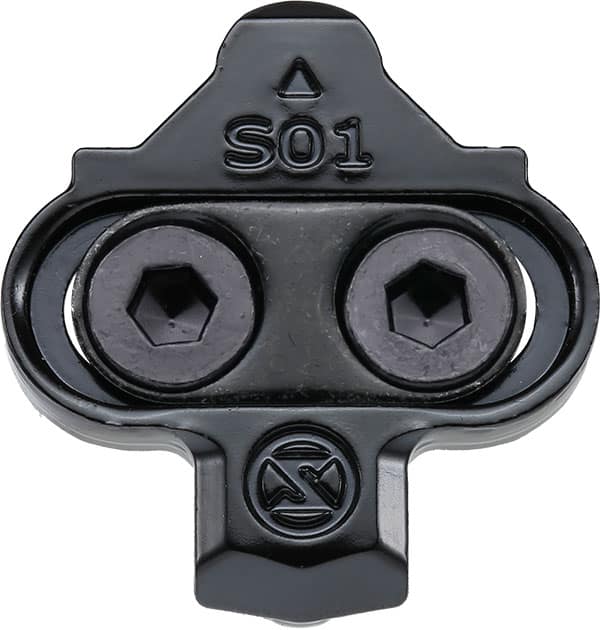
It’s the solution for a mountain biker who prefers flat pedals over clipless but who also might have a second bike or pair of clipless pedals to substitute for the flat pair.

Are flat pedals safer than clipless?
Every cyclist who upgrades to clipless pedals has experienced the embarrassment of not freeing their shoe cleat from the pedal body or bracket when they needed to.
You roll to a stop at the lights and, without thinking, go to slide your foot to the ground in a single coordinated movement, because in your mind you are
Instead, gripped by panic, you topple sideways, arms flailing in a desperate at- tempt to reduce the injury as the tarmac rushes up to meet arm or elbow.
Or hip, in one of the worst case scenarios.
Clipless Horror Story
A cyclist slows to a crawl on a gently descending road, preparing to ease past a hatchback creeping uphill from the opposite direction.
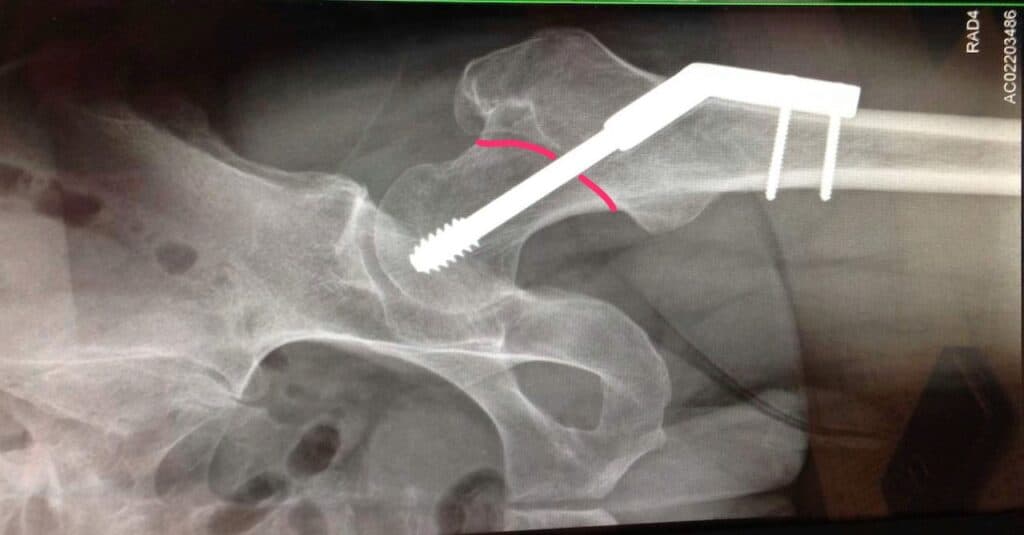
The road allows room for one car plus a little space on the side for a pedestrian or a cyclist.
The cyclist thinks about dismounting and walking the bike past the car. Having managed the maneuver several times over the years, though, he decides to ride on.
Hugging the edge, he glides to the rear of the vehicle and back out to the cen- ter of the road.
Failing to fully compensate for the slope, gravity takes hold; unable to clip out he topples with the slope, straight down at the road, hip impacting the pave.
The full weight of his body together with the slow speed ensures there’s no way out—his femur snaps cleanly just shy of the hip joint.
One titanium bolt screwed into pelvis and femur plus two operations later, the second a year after the first, the damage is repaired.
“Clip-in pedals?” accuses a policeman attending the accident scene.
The veteran officer sees clipless pedal mishaps a lot and can’t for the life of him understand why cyclists anchor themselves to their bikes with these lethal mechanisms.
And loves to let them know what he thinks. “Madness…!”
THE LAST WORD: Clipless/Flat is Not Either/Or
Sometimes things happen too fast, and too slow, or both at the same time in this case.
In this situation involving slow speed and tight maneuvering, dismounting then walking around behind the car would have been the smartest option.
Now, ditching those clipless pedals and installing flat pedals completely elimi- nates the danger of not clipping out during a future emergency, of course.
The broad platform and additional pins of a flat pedal, moreover, provide ex- cellent grip, eliminating the chance of a shoe slipping from the surface.
Nevertheless, pins can make a right mess of shins where riders botch high per- formance moves.
But sometimes freak accidents occur and the primary cause of the compound fracture described here was the cyclist’s overconfidence in his ability to control his bike.
A flat pedal would have allowed the cyclist to get that leg into contact with the road a split-second sooner, enough to buffer the fall.
There may have been some grazes, perhaps; there certainly would not have been compound fractures certainly.
In the end, there is no objective criteria to decide either way.
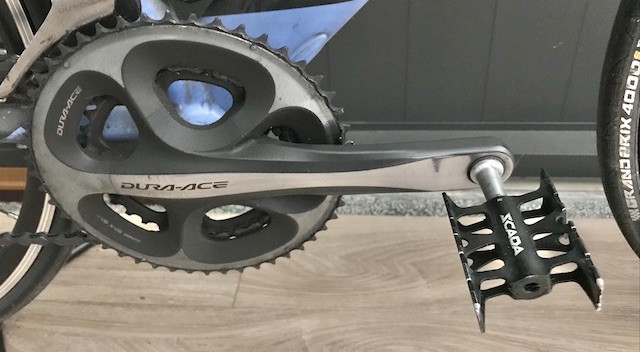
The cyclist in this case went on to use clipless pedals for several more years.
When that set of pedals wore out, he opted to replace them with, of all things, a pair of city bike pedals.
Functionally, the broad platform of the modern flat pedal is unnecessary; the
smaller cage of a city bike pedal fits neatly to the shoe, giving the minimal clipless ‘feel’; the rider’s happy.
Aesthetically, it does not look at all cool, particularly attached to a Dura Ace crank. Still, if it works for the cyclist, so what?
Clipless or flat?
Whatever suits in the context of use.